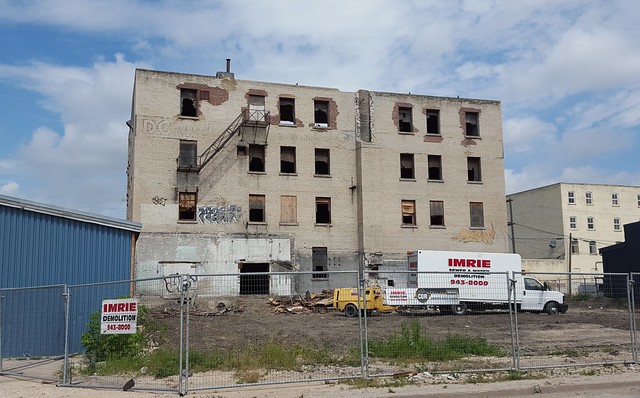Address: 743 Jarvis Avenue (Map)
Built: 1913
Architect: Unknown
1915 ad
This building was constructed at a cost of $70,000 for Dingle and Stewart, a Winnipeg-based produce wholesaler and food manufacturer. Their signature product was Melba Chocolates, sold across Western Canada.
The company was created ca. 1899, a partnership between Dudley Dingle, Guy Dingle and Duncan D. Stewart. By 1912 they had 200 employees and had outgrown their existing premises at 263 Stanley Street.
This building, which originally had a Parr Street address, was built as their confectionery manufacturing and canning facility. They retained the Stanley Street building for their fruit and vegetable wholesale business.
October 7, 1925, Winnipeg Free Press
In 1924 - 25 a national fruit price-fixing scandal rocked the nation. It involved a company called Nash, and allegations that they gave kickbacks and artificially inflated the wholesale cost of fruit to consumers. Dozens of distributors across the country were fingered as accomplices, including ten firms in Winnipeg. Dingle and Stewart was one of them.Charges of conspiracy were laid in October 1925 and it appears that soon after, Stewart and Dingle closed. In 1926 Dudley Dingle moved to Toronto.
Lyall, ca. 1926
Dominion Tanners was created ca. 1933 by Hugh Buxton Lyall, also see. The Ontario native was already well known for his key involvement in a number of large Manitoba businesses, including Dominion Bridge in Winnipeg and the Manitoba Rolling Mills in Selkirk.
Within a year, Dominion Tanners' Talbot Avenue plant with its ten workers was bursting at the seams and Lyall decided to lease the Dingle and Stewart Building for a huge expansion that would more than triple their workforce.
Tanning leathers was a dirty, smelly job and there was great opposition to having a tannery nearby, even in a largely industrial area. A number of surrounding businesses went on the record as being opposed to the relocation and a long petition was presented to council to stop it.
Dominion's defence was that people had the wrong idea of what they did. Tanning raw leather was a very small part of their business. Their main work was manufacturing leather for shoes, boots and gloves.
Council was invited to inspect - and sniff - their Elmwood facility to see what a "smell nuisance" it created. They agreed the odour was no worse that from other manufacturing plants and in June 1934 an occupancy permit was granted.
Dominion then spent about $40,000 to renovate the building and add new equipment.
The move was a good one for the company as business boomed. In 1936 they purchased the building outright and by 1941 had 60 full-time employees on the payroll.
On August 24, 1944, the building and business was nearly destroyed. Three firemen were injured when fire, fulled for hours by the barrels of wax, fish oil and tallow stored there, gutted the top floor. Water damage to the stock and equipment on the other floors was extensive.
A Tribune story noted: "Hundreds of people who packed the Arlington Street bridge had a grandstand seat. The scene from the bridge was breathtaking."
The company survived the fire and continued in business for six decades more. In 1948 Lyall sold the business to Conrad Sanford Riley. In 1967 the company moved to a newly-built, $2 million facility in the Inkster Industrial Park. It went bankrupt in 2003.
July 17, 1970, Winnipeg Free Press
The building was sold in 1970, after which it it has had numerous tenants. Mymor Industries made sheepskin products in the mid 1970s. In the 1970s and 1980s it was also home to a newspaper recycling firm.
In the late 1970s a series of insulation companies operated from this address, starting with Ray's and in the 2010s, Sure Save.
Related:
My Flickr album of the Dominion Tanners Building
UPDATE - July 2016: The building is being prepared for demolition.







No comments:
Post a Comment